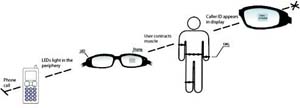| 2004 |

|
YEAR BOOK |
Media Lab Europe
|
Expanding human potential through invention
|

Media Lab Europe, the European research partner of the MIT Media Lab, is an independent, not-for-profit, international research institute. Established in July 2000 as a collaborative venture between the Irish Government and the Massachusetts Institute of Technology (MIT), the Lab is now well established in the former Guinness Hopstore in Dublin's growing Digital Hub.
Diversity
People are, and will continue to be, the most important resource at Media Lab Europe. Media Lab Europe invents by bringing together scientists, engineers and artists from different backgrounds, disciplines, cultures and nationalities to create technologies and explore applications that have barely been dreamt of before. With the research the Lab engages in and the tools it invents, science is being advanced, knowledge increased, boundaries extended and human life improved.
Partnership with academia and industry
The Lab's intentional focus on partnership with industry, academia and governmental organisations reflects its commitment to collaborative research and to the effective and timely practical transfer of research results and applications. The Lab's funding model enables its industrial research partners to engage in research to which they would not normally be exposed. Media Lab Europe also collaborates with Irish Universities whose participation is funded through a scheme administered by the Higher Education Authority (HEA).
Research and Innovation
Research activity at Media Lab Europe is organized into nine groups, each headed by a Principal Investigator. The research agenda at Media Lab Europe is designed to draw people together from a wide variety of backgrounds and disciplines and offer them substantial freedom to work together in identifying and exploring their research interests with passion and enthusiasm. Researchers at Media Lab Europe are encouraged to take risks � to aim high and tackle problems that are worth solving. Every research group focuses on the creation of working demonstrations of their research, aimed at bringing ideas to a 'proof of concept' stage that allows partners to envision practical applications which can enhance their business, product line, or life in general.
A major current theme at Media Lab Europe is Intimate Interfaces: bringing together inter-modal interfaces, biometric sensing, and rich representations to create intimate and personal connections with and through new technologies.
Intimate Interfaces � what are they?
Intimate interfaces change the way we interact with human-made objects and the ways we relate to other people via these objects. Intimate interfaces are ones you do not notice until they are missing. They connect people with things, the environment and each other in ways that augment human abilities, beyond the natural limits of our senses. In a world where technology is already everywhere, its expansion will mean deeper penetration into the niches of everyday life. Technology is and will increasingly be intimate with us.
Examples of Intimate Interfaces
tunA � Can anyone become a mobile radio station? tunA is a mobile wireless application that allows users to share their music locally through the creation of dynamic and ad-hoc wireless networks. Users can 'tune in' to other nearby tunA music players and listen to what someone else is listening to, and they are synchronized to enable the feeling of a shared experience
Aura Lingua (Hearing Tongue) explores a new kind of interface designed for the second most connected human organ: the tongue. Starting with simple audio display, this technology uses the tongue as an additional 'input channel' to the brain, and will eventually move towards more textured display as well as possibilities for gestural input, which is natural, intimate and covert.


Contact: Sorcha Duggan, Head of Partner Relations & Communications, Media Lab Europe;
Tel: +353 1 474 2800; E-mail: [email protected]